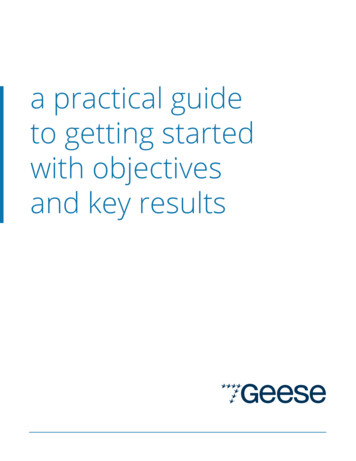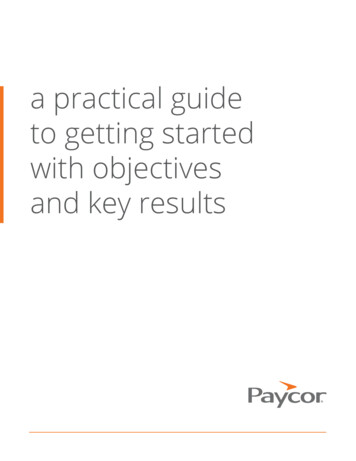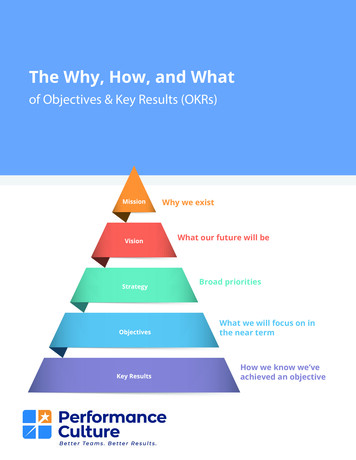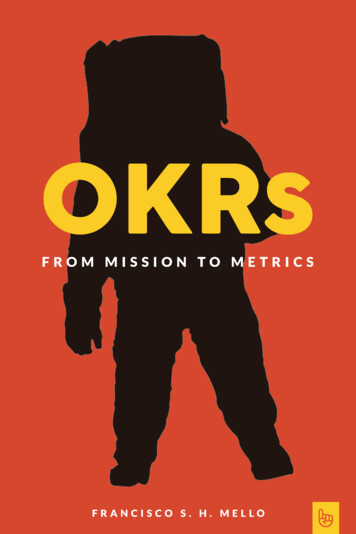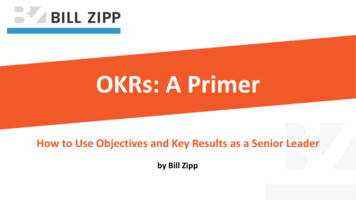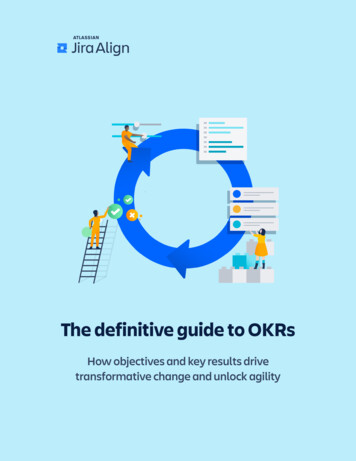
Transcription
The definitive guide to OKRsHow objectives and key results drivetransformative change and unlock agility
Table of Contents3Executive Summary6Introduction10What are OKRs?11OKRs and agility12OKRs vs MBO13OKRs vs key performance indicators (KPIs)13Why OKRs?1415Examples and scoringScoring17OKRs for leadership teams21OKRs for division and business unit leaders25OKRs for agile teams28What to watch out for30Dealing with failure30How to take the next step with OKR2
01Executive Summary
Executive SummaryResearch has shown that writing goals down increases the odds ofachieving them.1 In the 1990s, venture capitalist John Doerr popularizeda framework for setting and tracking aggressive goals knownas objectives and key results (OKRs.) Since then, large and smallcompanies, non profit organizations, athletes, educators, investors andmany others have embraced OKRs.Today, market forces, customer demands, economic changes, political conditions, and publichealth concerns make it necessary for companies to quickly adapt to change. Those who don’t, runthe risk of losing market share, revenue, and public trust. Command-and-control style leadershipteams become powerless to control change across an entire organization. Agile companies, on theother hand, give teams the freedom to set goals and to decide how to reach them. Flexibility andempowerment, the cornerstones of agility, are also the founding pillars of OKRs.OKRs provide guidance that promotes distributed decision making and keepsevery level of the organization engaged. Objectives in OKRs should be ambitious,short, and inspiring. Unlike the goals in management by objectives (MBOs), OKRsshould make you strive for peak performance. Scoring a perfect score usuallymeans the objective wasn’t a stretch. And unlike key performance indicators(KPIs), OKRs are meant to align with a company’s vision, mission, and values.If you do nothing to drive agility throughout your organization, at least implement OKRs. Here area few of the reasons why:·Agile teams experiment, fail, and learn as they go. OKRs don’t punish teams for going afteraggressive goals. Instead, they embrace a spirit of continuous learning and collaboration.·Agile teams are empowered to make decisions. It is understood they will make mistakesand learn from them. OKRs function in a similar way: they set a direction without mandatinghow the work will be done.·You can change throughout the year. You may discover that the goal you set for yourselfor your team is no longer relevant. Maybe market forces are now dictating a new direction.OKRs offer you the flexibility to make these changes. You can change goals that are nolonger relevant. And you can modify tactics that aren’t yielding the desired results.Matthews, G. (2015). Goal Research Summary. (Rep.) 9th Annual International Conference of the Psychology Research Unit ofAthens Institute for Education and Research (ATINER), Athens, Greece.14
Because agility is everybody’s mission regardless of where they fit in the organization, thisebook offers guidance to teams at every level.OKRs for leadership teamsSetting OKRs forces you and your teams to prioritize goals. As a leader, you need to securecommitment from your leadership team to get going. Setting OKRs doesn’t have to be a formalprocess, and you don’t need sophisticated tools. This ebook guides you step by step, and offerstips customized to your role.OKRs for business unit leadersYour job, once the top-level OKRs are communicated, is to define your own. We walk youthrough examples, and offer suggestions for creating and tracking bold goals and key results.Our advice is tailored to your job.OKRs for agile teamsTeams and individuals are empowered to adopt OKRs. OKRs not only push you to peakperformance; they also create a track record of your achievements. Take a look at our tips andadvice for teams.In this guide, we’ll also discuss the challenges you’re likely to face when implementingOKRs and how to adjust when things get difficult. Setting OKRs will challenge you to thinkabout strategic priorities. Although the process is simple, it isn’t always easy. Beware of settingthe wrong OKRs; they will cost you time, effort, and money. Watch out for too many objectivesor key results. Don’t set them in isolation: OKRs are a team sport. And stay away fromrigid cascading.If you don’t score a perfect score, don’t despair. Perform an honest assessment withyourself and your teams, put a mitigation plan in place or modify the key results.5
02Introduction
IntroductionHow many of us promised ourselves to exercise more in the newyear, train for a summer marathon, quit a bad habit, or strengthenour relationships with coworkers only to give up because we lostmotivation or couldn’t keep up the work to reach that goal? Accordingto Dr. Gail Matthews, professor of psychology at the DominicalUniversity of California, the failure to reach goals has a lot to do withlack of accountability.In 2015, Dr. Matthews presented the results of a global study on goal setting. The study foundthat over 70% of the participants who achieved their goals wrote them down and sent frequentupdates to their friends. In contrast, only 35% of those who kept the goals to themselvesmanaged to reach them.Here’s what the achievers in the study had in common:CommitmentAccountabilityRegular updatesThey committed to actionThey sent their commitmentThey followed up withby writing down their goalsto an accountabilityweekly updates to theirand the specific actions theypartner—a peer or friend.accountability partners.would take to reach them.Documenting goals has been common practice in the workplace for decades. In his 1954 bookThe Practice of Management, Peter Drucker coined the term “management by objectives”(MBO), and outlined a practice for setting goals that dominated corporate behavior for decades.In later years, MBO came under attack for placing too much emphasis on goal setting and notenough on creating a plan to achieve them. By the 1990s, Andy Grove, then CEO of Intel, hadimplemented objectives and key results (OKRs): a framework for goal setting that upended thetop-down management practice of MBO. Venture capitalist John Doerr popularized OKRs inthe ‘90s.Today, market forces, customer demands, economic changes, political conditions, and publichealth concerns make it necessary for companies to adapt quickly to change. Those who don’t,run the risk of losing market share, revenue, and public trust. Command-and-control styleleadership teams become powerless to control change across an entire organization. Agilecompanies, on the other hand, give teams the freedom to set goals and to decide how toreach them.7
OKRs, by allowing distributed goal-setting, create a framework that drives agility. Manyinnovative, household name companies use OKRs and swear by them: Google, Airbnb, Twitter,Atlassian, the Bill & Melinda Gates Foundation, and ING are a few.Market performance isn’t the only reason why companies embrace OKRs. Edwin Locke, apsychologist and pioneer in goal-setting theory, linked goal setting with self-confidence andmotivation.3 OKRs are rooted in the fundamentals of psychology and human behavior. Theyrepresent many of the elements below which, according to Dr. Locke, are important whensetting goals.····Goals need to be specificGoals must be difficult yet attainableGoals must be acceptedGoals are more effective when they areused to evaluate performanceDeadlines improve the effectivenessof goals·A learning goal orientation leads tohigher performance than a performanceFeedback must be given ongoal attainment··goal orientation·Group goal-setting is as important asindividual goal-settingSetting bold goals, writing them down, and holding yourself and your company accountablemake the difference between superior and lackluster performance. This guide will explainwhy OKRs promote agility; address the differences between OKRs, MBO, and KPIs; guide youthrough the process of setting goals and measuring progress; warn you about the behaviorsto avoid; and offer practical advice for when you fail to meet your objectives. Because agilityis everybody’s mission regardless of where they fit in the organization, this offers guidance toteams at every level.Locke, E. A., & Latham, G. P. (2006). “New Directions in Goal-Setting Theory.” Current Directions in Psychological Science,15(5), 265-268.38
03What are OKRs?
What are OKRs?OKRs offer a methodology for setting ambitious annual goals andmeasuring results throughout the year. Merely setting goals isn’tenough to get a company in a winning market position today. Oneof the biggest strengths of the OKR framework is it not only definesa shared direction throughout the company; it puts emphasis onexecution and tracking results.How do OKRs fit with your strategic imperatives? The yearly objectives, the O in OKRs, definewhat you will do and how you will do it.The objectives should:···Enable your vision, which conveys the value you bring to the customersSupport your company’s mission, which defines why the company existsAlign to your company’s values, which capture how you behave with your clients,employees, and stakeholders (See Figure 1.)Figure 1. How OKRs align with vision, mission and values10
Two components of OKRsObjectivesObjectives are qualitative. They should be ambitious, short, and inspiring. They should instill asense of meaning and get you out of bed in the morning with a feeling of excitement. Ambitiousobjectives make teams strive for peak performance. The philosophy behind OKRs is that if yourcompany is achieving 100% of its goals, the goals are too easy.EXAMPLEO: Deliver best-in-class customer experienceKey ResultsKey results are the metrics you use to track progress toward each objective. The best KRsare quantitative, possible, and measurable. You should plan for one to five key results foreach objective.EXAMPLEKR1: Improve the net promoter score from X to YKR2: Improve online engagement from B to COKRs vs MBOMany companies still use the MBO framework, while other companies moved away from it.MBOs placed too much emphasis on goal setting and not enough on creating plans to achievethem. OKRs still contain your objectives, but now offer a way to measurably show successtowards achieving them.OKRMBOGoal SettingBi-directionalTop-down onlyMeasurementQuantitative only withOften qualitative andambitious stretch goalssafe to achieveTransparencyOpen to everyoneHidden and privateTime FrameMonthly, quarterly, and annualAnnually set with quarterlysetting, measuring, and reportingreporting teamsAchieving success is clear,Ambiguous and open tomeasurable, and obtainabledifferent interpretationSuccess11
“OKRs are a clear way to drive the right behaviors.MATTHEW LAWRENCE, SENIOR GROUP PRODUCT MANAGER ATLASSIANOKRs and agilityOKRs operate in the spirit of accountability, empowerment, innovation, and flexibility, the sameprinciples that guide agility. The OKR framework promotes distributed decision-making, keepsevery level of the organization engaged, and allows teams to make decisions that support theirgoals. Even if you do nothing else to promote agility in your organization, implementing OKRswill put you on the path to agility.5 ways that OKRs put you on the path to agility1.Agile teams empowered to make decisionsAgile leaders don’t hand down instructions to their teams. It is understood they will makemistakes and learn from them. OKRs function in a similar way: they set a direction withoutmandating how the work will be done.2.OKRs create aspirationYou shouldn’t be hitting 100%, even when you’re doing everything right. If you are fallingshort, you can adjust what you do and how you do it. Flexibility is a key ingredient of agiledevelopment.3.Agile teams experiment, fail, and learn as they goOKRs don’t punish teams for going after aggressive goals. Instead, they embrace a spirit ofcontinuous learning and collaboration.4.Agile teams work in rapid review and delivery cyclesOKR proponents advocate frequent reviews. You can combine the question “Did we deliverthe things we said we’d deliver?” with “Did we achieve our objectives?” Asking bothquestions at the same time helps you decide whether to stay on the current path or change.5.You can choose to pivot or persevere throughout the year - that’s what agile meansYou may discover that the goal you set for yourself or your team is no longer relevant.Maybe market forces are now dictating a new direction. OKRs give you the flexibility to makethese changes. You can change goals that are no longer relevant. And you can modify tacticsthat aren’t yielding the desired results.12
How key performance indicators (KPIs) relate to OKRsMany businesses still use KPIs today to track business performance. You can use KPIs alongsideOKRs. KPIs, such as the number of website visitors or email conversion rates, are definitely worthtracking. KPIs work well for internal variance analysis, to find indicators for when your KRs misstheir goal. But KPIs are not a substitute for OKRs. Here’s why:·KPIs naturally inherit an output over outcomes based approach. For example, a KPI centeredon how many trial sign-ups you achieve, pushing you to do everything you can to increasethat number, may not achieve the right outcome for your business. You increase the numberof trials only to find at the end of the year, that your revenue did not increase at the samerate. By all accounts your team achieved success if measured solely by that KPI.·OKRs allow you to set objectives, measure the key results, and adjust if the key results aredriving the wrong behaviors.·OKRs set bold, aspirational goals. You won’t be hitting them 100% of the time. KPIs should berealistic and doable.Why OKRs?Setting OKRs isn’t easy. In fact, the process will challenge you. But the challenge has its payoffs.InnovationEmpowermentBold, ambitious goals serve as yourYou will be empowered to deliver results.north stars. Strong OKRs require newOKRs depict how you measure successideas, ways of working, and processes.towards your objectives but not how workReaching for them ignites innovation.gets done--that’s up to you.SimplicityAlignmentOKRs don’t depend on complicatedSetting and tracking OKRs is acalculations or tools. Simplicity is onecollaborative effort that brings theof their biggest strengths.organization together.AgilityFlexibilityOKRs promote agility. You may not meetIf the key results are not helping you reachall your goals, but you will learn fromyour objective, you have the freedom toyour mistakes and make adjustments.adjust them or get rid of them.DisciplineTransparencyEmployees can focus their talents onGoals and key results serve as a contract,the activities that bring the best results.visible to all, at any level.OKRs can drive focus, discipline, andemployee engagement.13
03Examples and scoring
Examples and scoringOKRs can be company-wide, specific to a function, for profit or non profit organizations.Executives, athletes, investors and students can use them. In fact, any organization, team orindividual committed to stretching themselves toward audacious goals can benefit from OKRs.Some OKRs may look good at first glance but once you examine them closely you discoverthey’re not well constructed.“With OKRs, success is a gradient. It is not black and white.CAMERON DEATSCH, CHIEF REVENUE OFFICER ATLASSIANWhy is this OKR good?Example 1O: Increase community and donorengagement·straightforward without being prescriptive.·The key results are clear, support theobjective directly, and lay out the metricsKR1: Grow donations by 20%.KR2: Increase the subscriber base byThe objectives are specific andthe organization needs to achieve.·The key results are neither too few nor toomany. Two to four results is ideal.25%, with half of new subscribersfrom the immediate community.KR3: Host one gala event withparticipation from a minimum ofthree new foundations.Why isn’t this OKR good?Example 2O: Become a market leader in ITconsultingKR1: Launch our new servicespackageKR2: Hold 5 webinars on IT·The key result is specific but it is binaryrather than iterative.·The key result is output focused. You wantyour KRs to be outcome focused.·The key result is not very measurable anddoesn’t indicate successconsulting15
There are various ways to score OKRs. Regardless of which you choose, remember the coreprinciples: OKRs are meant to stretch you and keep everyone engaged and accountable yearround. Before scoring, take the opportunity to reflect on how you did and what you need toadjust. OKRs are not about the scores you give yourself as much as, in the words of John Doerr,getting “everyone working on the right things.”It’s a good idea to score monthly. The question to ask when scoring is, “based on what I haveachieved so far, where do I think I will finish the year?” Each month, with the help of yourfinance or analytics team, create a snapshot of where you are against your metrics. With that inhand, assign a score to your performance on a scale from 0.0 to 1.0 to each key result, where 0.0means no progress toward your goal, and 1.0 means you will meet your stretch goal by the endof the year.···If you didn’t make progress: use scores 0.0 to 0.3.If you made progress but fell short of your overall goals: use scores 0.4 to 0.6.If you met or exceeded all your key results: use scores 0.7 to 1.0.Decide on the measures of success while setting your key results. This will make the rulesof the game clear.Let’s look at this example: KR: Sign up 150 new clients by the end of Q4. Whatwill constitute success? Obviously, signing up 150 customers will get a perfectscore of 1.0. But will signing up 100 customers get your team 0.6 or 0.7? Havingthis conversation before finalizing the key result will keep everyone on thesame page later on.The score for each objective is the average of the scores on your key results. If all your keyresults are on track and you are meeting expectations, you will score 0.7 on your objective.This also means your team is delivering on its financial commitments to the company. Scoring1.0 usually means that the objectives you set for yourself weren’t much of a stretch. Don’t fretscoring below 1.0. Stretch goals are a reflection of the culture of OKRs; they push teams tomaximize their potential.Figure 2. Scoring OKRsScoring 0.7 on a key result is a success. You should not feel like a failure if your teamend the year without a perfect score.16
04OKRs for leadership teams
OKRs for leadership teamsYour mission, should you choose to accept it: unite the companybehind common goals.OKRs are a vehicle you can use to lead your organization to enterprise agility. They provideguidance for ambitious goals, promote distributed decision making, and empower teams toset their own goals and measure progress. Flexibility and empowerment, the cornerstones ofagility, are also the founding pillars of OKRs. Agility and OKRs touch everyone, at all levels of theorganization: executives, business leaders, and teams.Figure 3. OKRs across the company.Notice the level you’re creating your OKRshould also align to the higher-level OKR.Good leaders know that setting goals forthe purpose of setting goals isn’t goodenough. Your objectives should align withthe strategic direction of the company. Youfirst need agreement on a three- to five-yearstrategic plan. OKRs should also support thecompany’s vision and mission. And becausethey will impact the behaviors of everyteam and practically every employee, theyshould be aligned with your values (seeReviewing previous objectives and setting new ones should be a formal process. Werecommend dedicating a day or two to discuss OKRs in a focused way. Start with aretrospective on the previous year’s OKRs. Look beyond whether you achieved success; discusswhether the OKRs drove the outcomes you hoped for, added value to your customers, andmoved the company closer to its vision. After you capture the learnings from the previous year’sOKRs, collaborate on a new set of OKRs. Review competitive information, emerging trends,market data, economic changes, and, most importantly, your customers’ needs.Setting OKRs forces you and your teams to prioritize what you want to accomplish during theyear. Prioritization is not easy. Some of the questions that will come up are: What did we dowell last year? What is different this year? What do we care most about?John Doerr uses a simple formula when setting OKRs: I will as measured by .18
You don’t need to over-engineer the process. All you need to get going is commitment and awhiteboard. Don’t worry too much about sophisticated tools. Below is an outline of the process.As you embark on it, keep this in mind: it is more a collaboration than a tops-down approach.While leadership will set the north star objectives for the business, they do not hand downobjectives for each level of the organization. You set the company objectives and trust theteams to align their objectives to the ones you set.The OKR creation process1.Review and discuss past company performance, market trends, and competitiveinformation.2.Which objectives in the coming year support your long term strategy? Create a long list.3.Rank the objectives based on business capabilities and congruence with thecompany vision.4.Pick the top three to four objectives and make sure they inspire change, movement, andexcitement for the entire company.5.Review your objectives with your company division leaders. It’s critical, before selectingthe proper KRs, to achieve alignment up, down, and across the organization onthe objectives.6.For each objective, select key results aligned with your strategy and company values. Forexample, the objective “Increase market share in Asia” can be supported by a number ofmeasurements: market share by volume, market share by currency, number of users, etc. Ifyou work for a software company and your goal is to increase mindshare, the number ofusers may be the best measurement.7.Review the key results with your company division leaders. Make sure thesemeasurements meet the criteria of a strong OKR, and are outcome based indicators ofsuccess for your objective.8.Share the OKRs across divisions and business units. The rest of the company will thendecide how to support these goals, and will go on to define their metrics. Invite your teamsto provide feedback on the high-level OKRs, and be prepared to ask them questions abouttheir own objectives and priorities.The high-level OKRs in our example look like this:EXAMPLEO: Increase market share in AsiaKR1: Increase the number of users in Asia by 10%KR2: Increase volume of product sold in Asia by 15%19
Tips for leadership teamsCommitmentLess is moreSetting OKRs requires commitment fromDon’t get carried away with objectives. Threeyou and everyone in your leadership team.to four objectives for the year is a goodWithout commitment at the highest level,number. Similarly, three to four key resultsthere is no point in taking on OKRs.per objective are usually enough.A healthy debateOwnershipSetting OKRs isn’t about filling out aAssign an owner from the leadership team totemplate. Engage your team in a healthyeach objective.debate about the company objectives andpriorities. The process may be painfulMeasurementat times but is healthy.If you can’t measure results, it will be difficultCommon languageDon’t spend time debating the meaningto track progress. The bestKRs are quantitative.of “strategic” or “objective.” Start with aCompensationfoundation of common language.OKRs shouldn’t be driving compensationAmbitionor promotions. Employees should be ableto take risks without fear of loss of income.Set audacious goals. The idea is that ifOKRs are often one of the inputs intoyou achieve all your objectives, you andemployees’ performance reviews. But theyyour teams are not stretched to peakaren’t the only input.performance. At the same time, you have tobe grounded in reality. The key is to find theNo prescriptionright balance.Key results do not tell your teams how toClear, short objectivesdo their jobs. KRs should define success, notthe work. They allow you and your teamsThe best objectives represent simpleample flexibility to choose how to meet yourconcepts.goals. If not, they are restrictions rather thanenablers.A contractOKRs become a contract between you andyour teams. Make sure you understand thedependencies between teams and howthey’ll execute the contract throughoutthe year .VisibilityShare your goals and metrics across thecompany. Visibility may feel uncomfortable,but is essential to the success of your goals.Even when your KRs slip.20
05OKRs for division and businessunit leaders
OKRs for division and businessunit leadersYour mission, should you choose to accept it: carry the torch.Your leadership team has created a set ofcompany objectives. Now what?Setting OKRs involves collaboration. Your job,once you have the top-level OKRs, is to definethe goals and key results that support thosecreated by your leadership team. And becauseOKRs are done in a spirit of teamwork andflexibility, you can adjust the objectives orsuggest different objectives to your leadershipteam whenever you think it’s necessary.Let’s look at examples of division-level OKRs, using this high-level OKR set by the leadershipteam in our previous section.COMPANY OKREXAMPLEO: Increase market share in AsiaKR1: Increase the number of users in Asia by 10%KR2: Increase volume of product sold in Asia by 15%There are different ways to support this objective. What you choose depends on your businessunit’s priorities and capabilities. However, your objectives should work to support the companylevel OKR, and should directly impact one or more KR.If your division is responsible for international marketing, your team sets an OKR that supportsincreasing the number of users in Asia.DIVISION OKREXAMPLEO: Establish an online presence in the Asian marketKR1: Achieve a social reach of 10,000,000 online active usersKR2: Improve our share of voice by 300%22
We understand, in marketing, that by creating social buzz and setting that as one of ourobjectives will ultimately help us achieve more active users. This type of OKR alignment is quiteapparent. However, not all OKRs seem aligned at first glance, even if they are.For an HR leader, the OKRs may look like this:EXAMPLEO: We are rated as the #1 workplaceKR1: Increase employee retention rate to 92%KR2: Improve net promoter score to 7.6Note that the HR objective doesn’t seem to directly align to the leadership OKR above, aboutimproving market share in Asia. And that’s OK. Not every part of the organization will seem toalign exactly with the top-level objectives. Some divisions or functions still need to account for“business as usual.” This doesn’t mean they can’t set aspirational goals.In this example, the HR leader should confirm that the HR objectives are not working againstthe higher-level objectives or those of other departments. Actually, because HR is focused oncreating the best workforce, that impacts having a strong employee presence and workplaceexperience, for the teams supporting the Asian market as well.Tracking and reviewingYou can’t set OKRs and forget them. The best way to stay on track is to check the progressagainst your goals frequently.We recommend a monthly cadence to cover the following:·Collect actual performance data across the business unit with the help of your finance oranalytics teams.··Review the results with the objectives’ owners.Have an honest conversation about the progress you made. What obstacles are in yourway? How can you remove them? What do you need to do differently?·Communicate with the rest of the organization and your leadership team, ask for feedback,and post the results on an intranet site or blog.23
Tips for business unit leadersFirst, take a look at the tips on page 20 for leadership teams. Many of these are applicable tobusiness unit leaders.1.Align cross-functionally. It’s important to understand the interdependencies across thecompany. Confirm that your goals are not conflicting with those of other functions orbusiness units. And if you depend on other business units to meet your goals, make surethey can support you.2.Assign an owner for each KR.3.Make sure you have good financial baselines to support your KRs.4.It is assumed that OKRs are time-bound. Most companies set OKRs every year and checkprogress monthly.5.Certain division-level OKRs, such as skills development and development operations, maynot roll up to the highest level OKRs--that’s OK.6.Don’t try to change the company roadmap so you can fit your own OKRs. If your businessunit is severely restricted by resources or other factors, ask for your leadership team’ssupport and create OKRs that stretch your teams while giving them a chance to succeed.7.Don’t blindly accept an objective handed down from leadership if you know there isabsolutely no way to achieve it.8.Remember, the best objectives are qualitative.9.Don’t create new metrics. Use established metrics that you and your teams will understand.10. You don’t need fancy analytics tools to have a good OKR review. A simple dashboardis enough.11. When communicating results with your teams, make the news helpful to your audience;highlight the ways in which employees can take initiative or solve problems.OKRs drive a culture of high achievement. You have to be willikng to fail and learnfrom your mistakes.24
06OKRs for agile teams
OKRs for agile teamsYour mission, should you choose to accept it: dive in.OKRs aren’t generated only at the top. Oncethe business units define their goals and keyresults, it is time for the product teams, ITdevelopment teams, HR teams and othersacross the company to do the same. Theteam-level OKRs should support the divisionand high-level OKRs. By setting and trackingOKRs, you will push yourself to perform ata higher level. OKRs can also create a trackreco
The OKR framework promotes distributed decision-making, keeps every level of the organization engaged, and allows teams to make decisions that support their goals. Even if you do nothing else to promote agility in your organizatio


